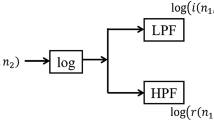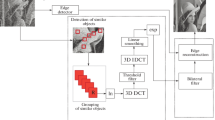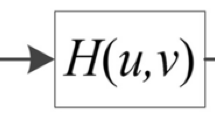Abstract
Signal Image separation is a significant processing task for accurate image reconstruction, which is increasingly applied to several medical imaging applications and communication areas. Most of classical separation approaches exploit frequency and time domains. These approaches, however are sensitive to noise, and thus often lead to undesirable results. In this paper, we propose a novel method of image separation. It incorporates the property of reflectance component extracted from the image and a Finite Ridgelet Transform (FRT) to obtain precise analysis of the images and thus correctly separate the images even in hardly noisy environment. We obtain the reflectance components of the target images by employing a homomorphic processing, which operates in the log domain, and thus can decompose the image into illumination and reflectance components. In addition, the homomorphic decomposition in the proposed method reduces information redundancy in the target image, and thus substantially improve the quality of image separation. We carried out extensive simulations, which demonstrate that the proposed homomorphic technique outperforms the conventional methods based on time domain and trigonometric transforms.






Similar content being viewed by others
Data availability
No datasets were generated or analyzed during the current study.
Code availability
Not applicable.
References
Abbass MY, Kim HW (2018) Blind image separation using pyramid technique. EURASIP J Image Video Process 2018:38
Almeida MSC, Almeida LB (2008) Wavelet-based separation of nonlinear show-through and bleed-through image mixtures. Neurocomputing 72(1–3):57–70
Almeida MSC, Almeida LB (2012) Nonlinear separation of show-through image mixtures using a physical model trained with ICA. Signal Process 92:872–884
Belouchrani A, Abed-Meraim K, Cardoso JF, Moulines E (1997) A blind source separation technique using second-order statistics. IEEE Trans Signal Process 45:434–444
Abbass MY, Kwon KC, Kim N et al (2021) A survey on online learning for visual tracking. Vis Comput 37:993–1014. https://doi.org/10.1007/s00371-020-01848-y
Ozgen MT, Kuruoglu EE, Herranz D (2009) Astrophysical image separation by blind time-frequency source separation methods. Digit Signal Process 2009:360–369
Candes EJ, Donoho DL (1999) Ridgelets: a key to higher dimensional intermittency? Philos Trans R Soc Lond A357:2459–2509
Candes EJ, Donoho DL Curvelets, Tech. report. Department of Statistics, Stanford University
Candes EJ, Donoho DL (2000) Curvelets: a surprisingly effective nonadaptive representation for objects with edges. Stanford Univ Ca Dept of Statistics
Cardoso JF, Laheld B (1996) Equivariant adaptive source separation. IEEE Trans Signal Process 44:3017–3030
Comon P, Jutten C (2010) Handbook of blind source separation: independent component analysis and applications. Academic, New York, pp 779–814
Elashry IF, Farag Allah OS, Abbas AM, El-Rabaie S, Abd El-Samie FE (2009) Homomorphic image encryption. J Electron Imag 18(3):033002. https://doi.org/10.1117/1.3167847
Abbass, M.Y., Kwon, KC., Alam, M.S. et al. Image super resolution based on residual dense CNN and guided filters. Multimed Tools Appl 80, 5403–5421 (2021). https://doi.org/10.1007/s11042-020-09824-3
Hammam H, Elazm AA, Elhalawany ME et al (2010) Blind separation of audio signals using trigonometric transforms and wavelet denoising. Int J Speech Technol 13:1–12. https://doi.org/10.1007/s10772-010-9066-0
Abbass MY, Kim H, Abdelwahab SA et al (2019) Image deconvolution using homomorphic technique. SIViP 13:703–709. https://doi.org/10.1007/s11760-018-1399-1
Hu C, Xu Z et al (2014) Semantic link network based model for organizing multimedia big data. IEEE Trans Emerg Top Comput 2:376–387
Huang Q, Hao B, Chang S (2016) Adaptive digital ridgelet transform and its application in image denoising. Digit Signal Process 52:45–54
Hyvärinen A (1999) Survey on independent component analysis. Neural Comput Surveys 2:94–128
Hyvärinen A, Oja E (1997) A fast fixed-point algorithm for independent component analysis. Neural Comput 9(7):1483–1492
Hyvärinen A, Oja E (2000) Independent component analysis: algorithms and applications. Neural Netw 13(4–5):411–430
Kim S, Yoo CD (2009) Underdetermined blind source separation based on subspace representation. IEEE Trans Signal Process 57:2604–2614
Li XL, Adali T (2010) Independent component analysis by entropy bound minimization. IEEE Trans Signal Process 58(10):5151–5164
Abbass MY, Kwon KC, Kim N, Abdelwahab SA, Abd El-Samie FE, Khalaf AAM (2020d) Utilization of deep convolutional and handcrafted features for object tracking. Optik 218:164926
Ozgen MT, Kuruoglu EE, Herranz D (2009) Astrophysical image separation by blind time-frequency source separation methods. Digit Signal Process 19:360–369
Rao KR, Yip P (1990) Discrete cosine transform. Academic, New York
Starck J-L, Candès EJ, Donoho DL (2002) The curvelet transform for image denoising. IEEE Trans Image Process 11:670–684
Walker JS (1999) A primer on wavelets and their scientific applications. CRC Press, Boca Raton
Abbass MY, Sadic N, Ashiba HI et al (2022) An efficient technique for non-uniformity correction of infrared video sequences with histogram matching. J Electr Eng Technol 17:2971–2983. https://doi.org/10.1007/s42835-022-01010-9
Wei Y, Wang Y (2016) Dynamic blind source separation based on source-direction prediction. Neurocomputing 185:73–78
Xiao L, Li C, Wu Z, Wang T (2016) An enhancement method for X-ray image via fuzzy noise removal and homomorphic filtering. Neurocomputing 195:56–64
Yu X-c, Xu J-d, Hu D, Xing H-h (2013) A new blind image source separation algorithm based on feedback sparse component analysis. Signal Processing 93:288–296
Yu XC, Xu JD, Hu D (2013) A new blind image source separation algorithm based on feedback sparse component analysis. Signal Process 93:288–296
Zhang H, Wang G, Cai P, Wu Z, Ding S (2014) A fast blind source separation algorithm based on the temporal structure of signals. Neurocomputing 139:261–271
Zhang Y, Yang D, Qi R et al (2016) Blind image separation based on reorganization of block DCT. Multimed Tools Appl 75:12101–12121. https://doi.org/10.1007/s11042-016-3397-z
Author information
Authors and Affiliations
Contributions
Not Applicable.
Corresponding author
Ethics declarations
Ethical approval
This article does not contain any studies with human participants performed by any of the authors.
Informed consent
Not Applicable.
Conflict of interest
Not Applicable.
Additional information
Publisher’s note
Springer Nature remains neutral with regard to jurisdictional claims in published maps and institutional affiliations.
Rights and permissions
Springer Nature or its licensor (e.g. a society or other partner) holds exclusive rights to this article under a publishing agreement with the author(s) or other rightsholder(s); author self-archiving of the accepted manuscript version of this article is solely governed by the terms of such publishing agreement and applicable law.
About this article
Cite this article
Abbass, M.Y. Homomorphic technique for image separation. Multimed Tools Appl 83, 18639–18648 (2024). https://doi.org/10.1007/s11042-023-15155-w
Received:
Revised:
Accepted:
Published:
Issue Date:
DOI: https://doi.org/10.1007/s11042-023-15155-w




